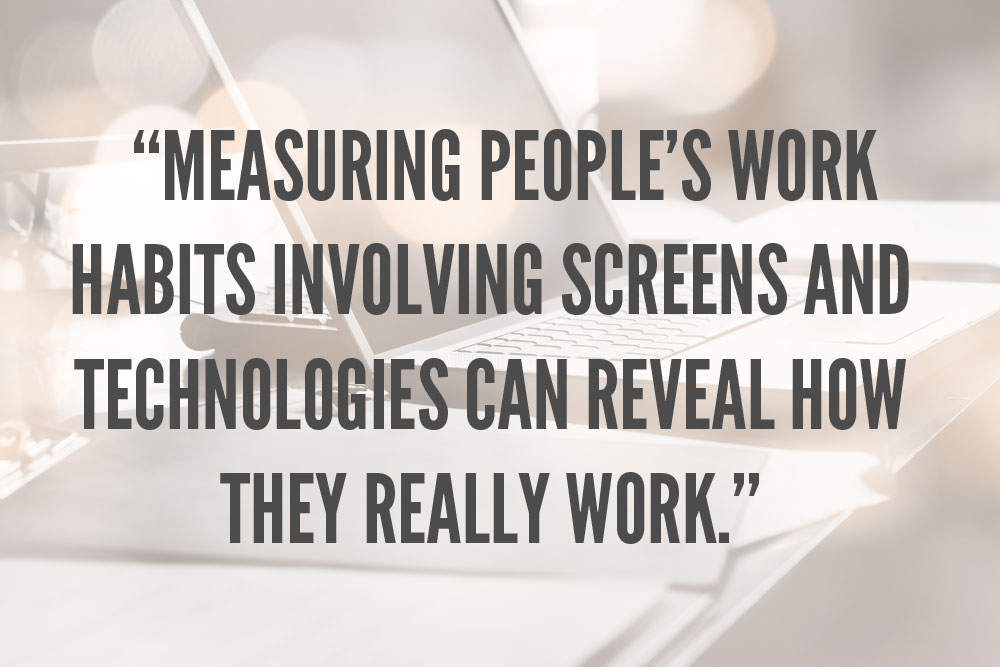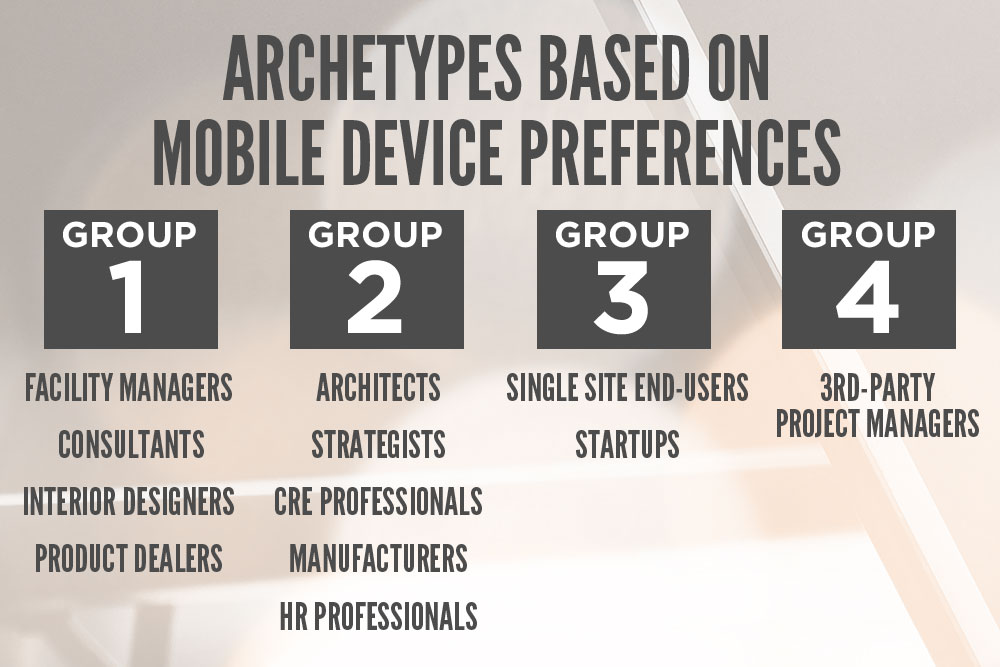Together with our research partner Survature, we launched a survey to learn more about what screens tell us about how people really work. Between May 14th – 31st of this year, 368 of you participated in our research. Here is part one of the results!
Research Background
Modern-day workplaces are at the epicenter of change. Many amazing new workspaces have come into being because of new ideas in workplace strategy. However, knowing what design strategies are best at improving “how people work” in a customized and targeted manner is still an art, not a science.
A key reason for this is that how people say they work doesn’t match up with how they really work. This often leads designers to resort to “best guesses” or experience on prior projects to create the right workplace for a client. Unfortunately, it’s nearly impossible to get a design 100 percent right for how people in a given workplace really work without collecting proper data. Because traditional methods have not provided a robust lens for capturing this much needed information, Survature and Work Design partnered together on a research project on “The Screen-Centric Future Workplace” to see if there can be a new way.
The idea of the Screen-Centric Future project has roots dating back to the 1980s when Ubiquitous Computing was first discussed by world renowned researchers at Xerox PARC (Palo Alto Research Center). PARC has shaped many aspects of the information age. For example, the computer mouse was invented there.
Since the very beginning, Ubiquitous Computing was about making computing human-centered, so that people don’t carry “computing” with them. Wherever they want to work, “computing” is already there for them. Screens happen to be a primary human-computer interface and in many ways, also a primary human-technology interface. To end users, in a stealth and inconspicuous manner, ubiquitous computing can exemplify itself as ubiquitous screens.
Hence, in 2017, when the National Science Foundation chose the “Future of Work at the Human-Technology Frontier” as a national “Big Ideas” initiative, that was not coincidental. It’s only logical. Now is the time to prepare for this upcoming technology-centric transformation both inside and outside the workplace.
A Human-Centered Hypothesis
Workplace design has always strived to be human-centered. However, as technology and computing are becoming a central part of workplaces, getting deeper information about how technologies are getting integrated into work may help shed new light on how people really work. This thinking led us to our research hypothesis, which is: Measuring people’s habits involving screens and technologies can reveal how they really work.
Habits are things that we do frequently but with little conscious considerations. Probing people’s habits has been very hard due to the limitations of old-school survey techniques still in use today. In this study, we leveraged Survature’s behavior-enabled survey (BES) platform which allowed us to get over that barrier and dig further into people’s psychology to understand their true habits.
In addition, how people work goes far beyond task-efficiency or simply how quickly people complete work. As the transformation in today’s workforce continues, especially in the technology and service-oriented sectors, it is key to empower workers to be full-fledged knowledge workers. If you are unfamiliar with this term first coined by Peter Drucker in 1959, knowledge workers are often described as those that solve complex problems by thinking for a living rather than performing physical tasks. In this study, we augment our analytical power by digging further into the dynamics among knowledge workers in an innovation-heavy world.
Screen-Centric Future vs. Screen-Centric Present
The Work Design audience is one of the best examples of an innovation-heavy and service-oriented workforce. Between May 14th – 31st of this year 368 of you participated in our research by responding to our survey.
Since readers of Work Design Magazine are thought leaders and creators who will shape the future of work, we felt this was the perfect audience to verify how some designs are good fits with knowledge workers of different professions. The 368 participants include: architects, interior designers, strategists, consultants, product manufacturers, facility managers, end users, project managers, furniture dealers, brokers, and HR professionals.
This makes our study a little different than most as you, the reader, are not only the provider of our data but also the consumer. The data we collected is compelling. It reveals an urgency that the screen-centric future is already here.
Data shows that, on average, knowledge workers already use about 4 screens every day at work. You might assume that younger generations are more likely to show above average screen use day-to-day, we found that this is NOT the case. Instead, it is the 35-44 and 45-54 age groups that are leading this increased screen use at work. Moreover, the 55-64 age group still has comparable levels of screen use as the younger 25-34 age group. In fact, the youngest age group, 18-24, uses the fewest screens when compared with all age groups.
So, the screen-centric world is not revolving around youth. Rather, it is something that revolves around the various types of work responsibilities and position levels.
The trend is not that everyone is on laptops either. Among workplace professionals, only 22 percent rely solely upon their portable screens for daily work. The remaining 78 percent either prefer fixed screens or a mixture of fixed and portable screens.
In addition, data shows that people’s preferences regarding mobile devices is a good predictor of how professions are similar or different. Based on that predictor, we have discovered four archetype groupings among all the professions within the Work Design audience.
- The first archetype includes: facility managers, consultants, interior designers, and product dealers.
- The second archetype includes: architects, strategists, CRE professionals, manufacturers, and HR professionals.
- The third archetype includes: single site end-users and startups.
- The fourth archetype includes: solely 3rd-party project managers.
What’s Next
Of course, when we dig deeper into the data, there can be a million stories to tell. We have organized our most interesting findings into three subsequent articles.
First, the function of a space heavily depends on who is using it (or designing it). People are likely to see different things in the same space due to their varying experiences. That’s not a surprise. What is a surprise in our discoveries is the disagreements among the design community regarding the best use of various space designs. For instance, the data shows that we don’t like open office spaces ourselves, even though we design those spaces. We will discuss more about design concept evaluation in the upcoming article: “Space Functionality is in the Eye of the Beholder”
Second, knowledge workers share leadership and intellectual contributions in their workplace. Through our research, we found new metrics that can reveal those aspects. The metrics are both powerful and easy-to-use. They have the specificity and reliability required to penetrate through noise and capture team dynamics in the workplace. We will discuss the details of those instruments in our third article.
Third, the workplace industry dares to try bold new ideas and some work amazingly well. However, we need to also recognize that human outcome within a built space depends on how occupants truly make use of the spaces. Based on our new abilities to measure what people do and how they really work, we can show why a particularly bold idea can work well and in what context it works particularly well. The example of a new idea we’ll examine in our fourth article is a library space at work.
In summary, “how do people really work?” is a tough question for humans to answer reliably. Even though perception biases do apply, there are deeper reasons. That is, we don’t consciously think or reason about our habits, because habits are something we do with little or no conscious consideration. Put a different way, people’s most honest answers cannot communicate their habits with true meaning and substance.
So, when we need to dig into people’s habits in order to better understand how they really work to design to best workplace possible, we should rely on better data to tell the story.








[…] Together with our research partner Survature, we launched a survey to learn more about what screens tells us about how people really work. Between May 14th – 31st of this year, 368 of you participated in our research. Here is part two of the results! Make sure to read part one here. […]
[…] in our research. Here is part two of a deeper dive into the results! Make sure to read the overview here and part one […]